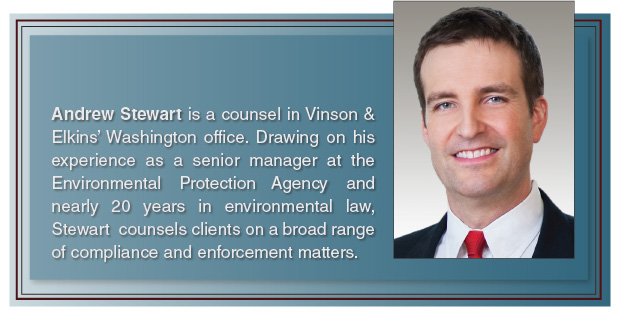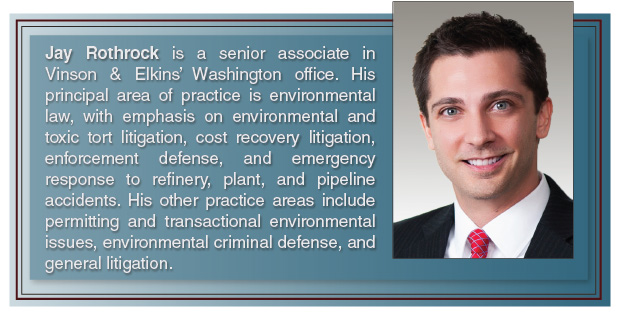
EPA Initiatives
Agency Puts Oil & Gas In Crosshairs
By Andrew Stewart and Jay Rothrock
WASHINGTON–On Feb. 18, the U.S. Environmental Protection Agency announced its National Enforcement Initiatives (NEIs) for fiscal years 2017-19. As in past years, several of these are particularly relevant to oil and gas operations.
Both civil and criminal enforcement offices at EPA will dedicate focused resources toward the industrial activities covered by the NEIs, including oil and gas operations, as part of a nationwide program. EPA identifies NEIs every three years to focus its resources on “the most important environmental problems where noncompliance is a significant contributing factor, and where federal enforcement attention can make a difference.”
The FY 2017-19 NEIs take effect on Oct. 1.
EPA also plans to aggressively promote its “next generation compliance (NGC)” measures in investigations and settlements, including incorporating into settlement agreements requirements to implement technologies and practices not specifically required in regulations. Such expanded requirements are untested in court.
For example, as part of its NGC measures, EPA will seek to obtain settlements of enforcement actions that include provisions requiring increased “transparency.” These provisions require regulated entities to share more information regarding their emissions and other environmental data with the communities in which they operate, usually through publicly-accessible websites. Sharing such data, particularly when it is not subjected to quality assurance/quality control procedures, could provide fodder for plaintiff lawyers and citizen groups to bring lawsuits against oil and gas facilities.
Energy Extraction Initiative
EPA renewed its existing enforcement initiative focused on energy extraction and production activities. This NEI was introduced in 2011 in response to the dramatic growth of shale gas production. Under the 2011 initiative, EPA has averaged more than 700 inspections and evaluations of extraction activities annually from FY 2012 to 2015, up from only 361 in FY 2011.
In furtherance of this priority, the agency has initiated hundreds of enforcement actions under a number of federal statutes, and also has invoked emergency authorities under the Safe Drinking Water Act and the Comprehensive Environmental Response, Compensation, and Liability Act. Some of these matters include civil judicial cases that have resulted in millions of dollars in penalties and substantial injunctive relief measures.
Additionally, EPA indicated it intends to utilize NGC technologies and techniques to identify and address noncompliance. These measures will include advanced monitoring and remote sensing technologies, third-party compliance audits, electronic reporting, and the public release of pollution data.
The agency has indicated that it is developing remote monitoring capabilities for water sources that could be deployed to investigate potential noncompliance at oil and gas operations. Such technologies, paired with geographic information system software, and practices such as overflights, allow EPA to identify regulated facilities with far greater precision, and to achieve a larger inspection “footprint” than before. Utilizing these tools, government investigators will seek to home in on violations occurring near communities and sensitive environmental areas, such as impaired water bodies.
An EPA compliance alert signals that Clean Air Act inspections and enforcement activities will be a focus of the energy extraction NEI. From EPA’s perspective, air investigations lend themselves well to the use of NGC equipment, and the agency already has incorporated provisions that require using optical gas imaging technologies in settlements addressing noncompliance at natural gas facilities.
Moreover, the CAA is particularly attractive to EPA as an enforcement vehicle because it contains fewer exemptions for oil and gas activities than other federal environmental statutes.
Going After Methane
The legal requirements EPA will be enforcing under its energy extraction priority only will expand as the agency moves forward with the NEI. Both the EPA and the Department of the Interior are slated to finalize oil and gas regulations this year that will impose significant compliance obligations and costs as part of the Obama administration’s initiative to reduce methane emissions from the oil and gas sector by 40-45 percent by 2025.
For example, EPA plans to finalize CAA New Source Performance Standards that will regulate methane directly with rules that apply for the first time to several types of upstream and midstream facilities and operations that are new or have been modified since Sept. 18, 2015. These facilities include compressor stations, production gathering and boosting stations, natural gas processing plants, and well sites.
Under the proposed NSPS, both well sites and compressor stations would have to comply with new leak detection monitoring and repair requirements for fugitive volatile organic compounds and methane emissions. These monitoring requirements are expected to be particularly onerous, as they impose tight timelines and ongoing monitoring and repair requirements. EPA projects it will issue a final rule in June.
Then in March, the Obama administration announced in a joint statement on climate with Canada that EPA “will begin developing regulations for methane emissions from existing oil and gas sources immediately, and will move as expeditiously as possible to complete this process.”
Thus, similar methane emission-control requirements could apply to hundreds of thousands of existing sources within the 2017-19 window covered by the energy extraction NEI. Such a regulation could bring particularly tough challenges for aging wells operating at thin profit margins.
Targeting Federal Lands
EPA is not the only federal agency planning to finalize additional regulations for the oil and gas industry in the Obama administration’s home stretch. The Bureau of Land Management administers 245 million acres of federal surface lands, and more than 60,000 wells operate on those lands. Upstream activities on BLM lands became a greater focus after BLM released a comprehensive rule governing hydraulic fracturing in 2015.
The final rule includes new wellbore integrity requirements, imposes standards for interim storage of recovered waste fluids, and requires notifications and waiting periods for key parts of the fracturing process, which could lead to delays in operations. The U.S. District Court for the District of Wyoming has issued a preliminary injunction halting enforcement of the final rule. Environmental groups’ appeal to this ruling is likely to be heard this year.
On Feb. 8, BLM published a proposed rule aimed at reducing natural gas lost through venting, flaring, and equipment leaks from both new and existing production activities on federal lands. Under BLM’s proposal, operators would be charged royalties on gas losses from onshore federal leases, except where the loss is unavoidable, as defined by the proposed rule.
BLM specifically proposes to focus on reducing gas lost from:
- Flaring of associated gas from development oil wells;
- Leaks from well-site equipment and facilities;
- Leaks from compressors, high-bleed pneumatic controllers and certain pneumatic pumps;
- Emissions from vessels;
- Downhole well maintenance and liquids unloading; and
- Well drilling and completions.
The rule is projected to be finalized in June.
HAP And NSR/PSD
EPA will expand its enforcement initiative aimed at cutting hazardous air pollutants, which began in 2004. This initiative will continue to focus on emissions from leaks and flares, as well as excess emissions, including those associated with upstream oil and gas production.
However, for 2017-19, EPA has expanded the initiative to also include large product storage tanks (such as those likely to be used at refineries, chemical plants and bulk storage facilities).
EPA also renewed its enforcement initiative aimed at reducing air pollution from the largest sources, which it has pursued since 2005. This initiative is driven largely by enforcing the CAA’s New Source Review (NSR) and Prevention of Significant Deterioration (PSD) programs, which generally require owners of certain large industrial facilities to install state-of-the-art pollution controls when building new facilities or significantly modifying existing facilities.
Historically, NSR and PSD enforcement has focused primarily on refineries, coal-fired power plants, and acid, glass and cement manufacturing facilities. Nonetheless, EPA could pursue enforcement against sources such as condensate tank batteries that the agency believes trip NSR or PSD requirements.
Moreover, the PSD and NSR programs are a concern for oil and gas operations because of EPA’s practice of “aggregating” emission sources. The more activities EPA aggregates into a “source,” the more likely it is that the source will trigger additional CAA requirements, including permitting, extensive and costly analyses of emissions, and even more stringent pollution controls.
Indeed, after years of uncertainty and inconsistency, in 2015 EPA proposed to amend its PSD, NSR, and Title V air permitting program regulations to clarify the definition of “adjacent” for the purpose of making source determinations for the oil and natural gas sector. EPA says its intent is to streamline the permitting process and produce more consistent and predictable source determinations in light of uncertainty created by its prior guidance on adjacency, as well as recent litigation.
Under EPA’s preferred option, a source would include all the emitting activities located on a property as well as those sources that “are contiguous or are located within a short distance (one-quarter mile) of one another.”
The NOPR offers a second option that defines adjacent to include all the emitting activities captured by its preferred option as well as sources beyond a quarter mile that are functionally related. This more subjective option would lead to continuing uncertainty and confusion regarding aggregation determinations, leaving the ultimate decision in some cases to the federal courts. EPA projects it will finalize this source aggregation rule in June.
High-Risk Facilities
EPA added a new enforcement initiative for FY 2017-19 focused on reducing the risks of accidental releases at industrial and chemical facilities. According to the September 2015 Federal Register notice, in which EPA solicited public comment on its proposed FY 2017-19 NEIs, this initiative is aimed at a broad range of facilities, including those that produce and store extremely hazardous substances.
Many of the most significant incidents in the oil and gas sector have occurred in downstream operations such as refineries, but upstream operations will not be excluded from EPA’s purview under this new priority. Indeed, upstream operations face risks such as explosions, blowouts and fires, and some experts believe fatalities in the upstream industry are underestimated.
EPA has said approximately 150 catastrophic accidents occur annually across the facilities it regulates. For this enforcement initiative focused on accidental releases, EPA has identified about 2,000 facilities it considers high risk because of one or more of the following factors:
- Proximity to densely populated areas;
- The quantity and number of extremely hazardous substances; or
- A history of significant accidents.
EPA’s goal is to reduce the risk of accidents through “innovative accident prevention measures and improving response capabilities,” likely relying on authorities such as the CAA’s Risk Management Plan rule. The RMP program requires facilities to report certain hazardous chemicals to EPA and to reduce risks associated with their accidental release. Pending revisions to the RMP program could require facilities to:
- Complete third-party audits following an accident;
- Consider inherently safer technology; and
- Conduct root-cause analyses and take any necessary corrective actions.
The revisions also would impose broad information-sharing requirements with emergency planners and the public.
EPA also has introduced an enforcement initiative designed to keep industrial pollutants out of the nation’s waters. This initiative will focus on several industries that contribute a “disproportionate” amount of nutrient and metal contamination above discharge limits–specifically mining, chemical manufacturing, food processing, and primary metals manufacturing. Although EPA does not appear to be keying on the oil and gas industry with this new water priority, the agency typically adjusts the focus of its priorities as it implements them, and potentially could add a focus on oil and gas operations as it gathers more information about industrial impacts to impaired waterbodies.
Looking Ahead
Because oil and gas operations are the subject of the NEIs outlined here, owners and operators should expect disproportionate EPA enforcement attention through at least 2019. These efforts will not be limited to civil enforcement only; the likelihood of criminal enforcement increases in programs that EPA identifies as NEIs.
Although EPA sets the NEIs, many of the activities necessary to further these initiatives occur at the regional or state level. EPA will update its National Program Managers Guidance to provide its regional offices, as well as state and tribal partners authorized to implement EPA programs, with guidance that identifies the FY 2017-19 NEIs, and will assign will activities that it expects to be carried out by the regions and states. In practice, regions are required to make specific numerical commitments to EPA headquarters for conducting inspections and taking enforcement actions related to each of the NEIs.
These region-specific goals could have important implications for the distribution of enforcement actions related to specific NEIs. For example, given the large number of oil and gas operations in states such as Texas, Oklahoma, North Dakota and Pennsylvania, EPA Regions 6, 8 and 3 are likely to play a particularly active role in the ongoing energy extraction initiative.
Moreover, EPA regions have distinct “enforcement philosophies” and approaches to conducting investigations and addressing noncompliance in the oil and gas sector. For example, EPA Region 3 tends to focus on field inspections in Pennsylvania and, to a lesser extent, West Virginia. Region 6, on the other hand, often utilizes investigatory approaches such as overflights that allow personnel to cover large geographic areas and address a substantial number of sources.
Although EPA resets its NEIs every three years, owners and operators in the upstream industry should expect to remain in the federal crosshairs for much longer; NEIs often are renewed for multiple cycles, and several of the current NEIs–including EPA’s energy extraction initiative–relate to programs identified as priorities several years ago.
The upcoming presidential election is unlikely to materially alter EPA’s focus on the areas it has identified in the short or medium term. Any attempt by a new administration to rescind any of these enforcement priorities likely would face stiff opposition. Opposition measures could include citizen suits, potential investigations by EPA’s Office of Inspector General and the Government Accountability Office, and congressional investigations and hearings.
Editor’s Note: This article is intended for educational and informational purposes only, and does not constitute legal advice or services. These materials represent the views and summaries of the authors. They do not necessarily reflect the opinions or views of Vinson & Elkins’ LLP or of any of its other attorneys or clients.
For other great articles about exploration, drilling, completions and production, subscribe to The American Oil & Gas Reporter and bookmark www.aogr.com.








